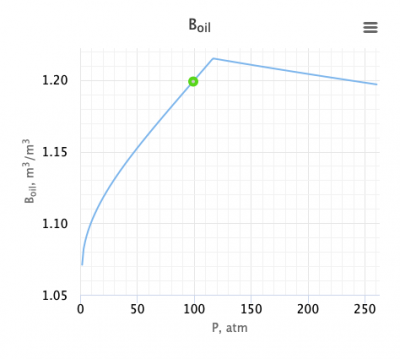Difference between revisions of "McCain Oil Formation Volume Factor equation"
From wiki.pengtools.com
(→Math & Physics) |
|||
| Line 9: | Line 9: | ||
== Math & Physics == | == Math & Physics == | ||
| − | + | :<math>B_o} = \frac{\rho_{STO}+1.22117R_s\gamma_g}{\rho_{oR}}</math> | |
| − | |||
| − | |||
| − | |||
| − | |||
| − | |||
| − | |||
| − | |||
| − | |||
| − | :<math> | ||
| − | |||
| − | |||
| − | |||
| − | |||
| − | |||
| − | |||
| − | |||
| − | |||
| − | |||
| − | |||
| − | |||
| − | |||
| − | |||
| − | |||
| − | |||
| − | |||
| − | |||
| − | |||
| − | |||
| − | |||
| − | |||
| − | |||
| − | |||
| − | |||
| − | |||
| − | |||
| − | |||
| − | |||
== Example. Calculation of the oil density == | == Example. Calculation of the oil density == | ||
Revision as of 10:28, 28 September 2020
Contents
McCain Oil Formation Volume Factor correlation
McCain correlation is an empirical correlation for the oil formation volume factor published in 1990 [1].
Math & Physics
- Failed to parse (syntax error): B_o} = \frac{\rho_{STO}+1.22117R_s\gamma_g}{\rho_{oR}}
Example. Calculation of the oil density
Example source [2]
Input data
 = 53.24 sm3/sm3
= 53.24 sm3/sm3 = 0.85 or 35 API
= 0.85 or 35 API = 0.75
= 0.75 = 90C or 363K
= 90C or 363K = 10 MPa
= 10 MPa
Calculate oil density at p = 10 MPa?
Solution
 = 749.645 kg/m3
= 749.645 kg/m3
The solution is available in the online PVT calculator software model at www.pengtools.com
Application range
Description of the Data Used[3]:
Number of data sets = 684
Nomenclature
 = oil compressibility, 1/psia
= oil compressibility, 1/psia = pressure, psia
= pressure, psia = solution gas-oil ratio, scf/stb
= solution gas-oil ratio, scf/stb = gas specific gravity, dimensionless
= gas specific gravity, dimensionless = gas specific gravity at separator pressure, dimensionless
= gas specific gravity at separator pressure, dimensionless = oil specific gravity, dimensionless
= oil specific gravity, dimensionless = temperature, °F
= temperature, °F
 = apparent density of surface gas if it were a liquid, lbm/ft3
= apparent density of surface gas if it were a liquid, lbm/ft3 = liquid density at the bubble point pressure, lbm/ft3
= liquid density at the bubble point pressure, lbm/ft3 = liquid density at reservoir pressure and 60°F, lbm/ft3
= liquid density at reservoir pressure and 60°F, lbm/ft3 = oil density, lbm/ft3
= oil density, lbm/ft3 = pseudoliquid formed by recombination of surface gas and liquid at standard conditions, lbm/ft3
= pseudoliquid formed by recombination of surface gas and liquid at standard conditions, lbm/ft3 = adjustment to liquid density due to pressure, lbm/ft3
= adjustment to liquid density due to pressure, lbm/ft3 = adjustment to liquid density due to temperature, lbm/ft3
= adjustment to liquid density due to temperature, lbm/ft3
Subscripts
- b - bubble point
- g - gas
- o - oil
References
- ↑ McCain, W.D. Jr. (1990). Properties of Petroleum Fluids (2 ed.). Oklahoma: PennWell Corp. ISBN 978-0878143351.
- ↑
Wolcott, Don (2009). Applied Waterflood Field Development
 . Houston: Energy Tribune Publishing Inc.
. Houston: Energy Tribune Publishing Inc.
- ↑ McCain, W.D. Jr.; Hill, N. C. (1995). "Correlations for Liquid Densities and Evolved Gas Specific Gravities for Black Oils During Pressure Depletion"
 . Society of Petroleum Engineers (SPE-30773-MS).
. Society of Petroleum Engineers (SPE-30773-MS).







